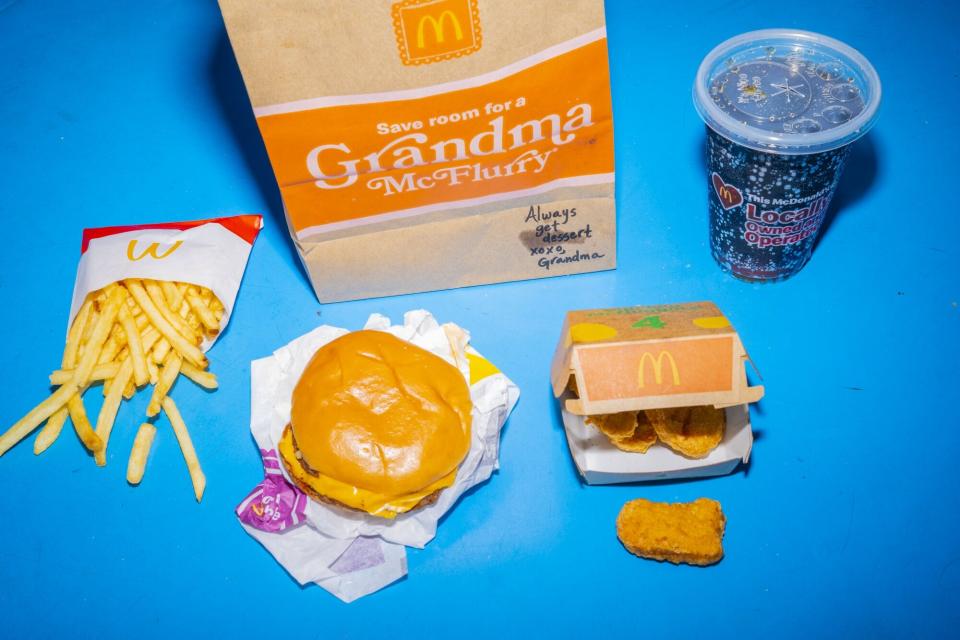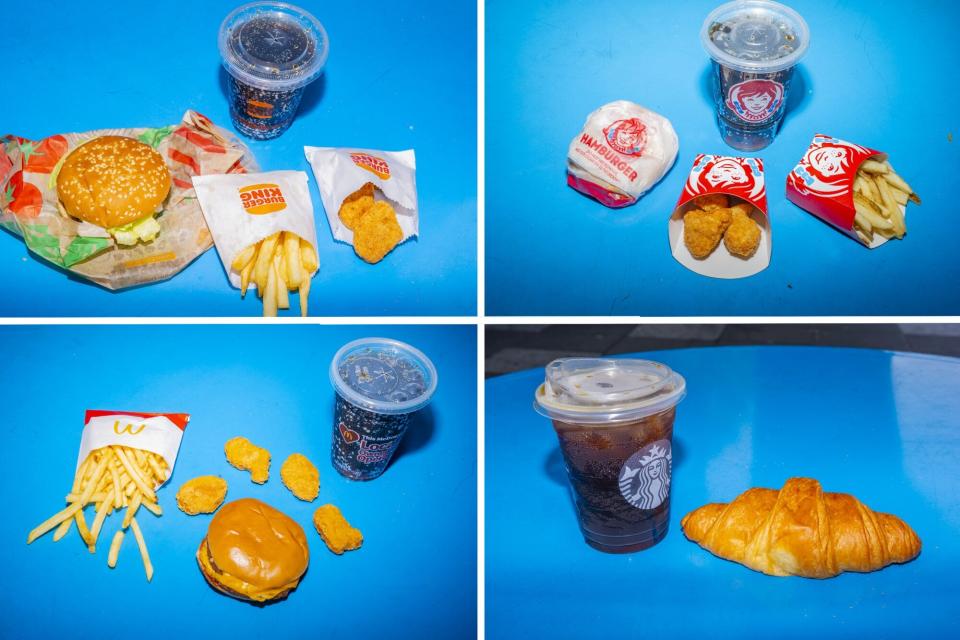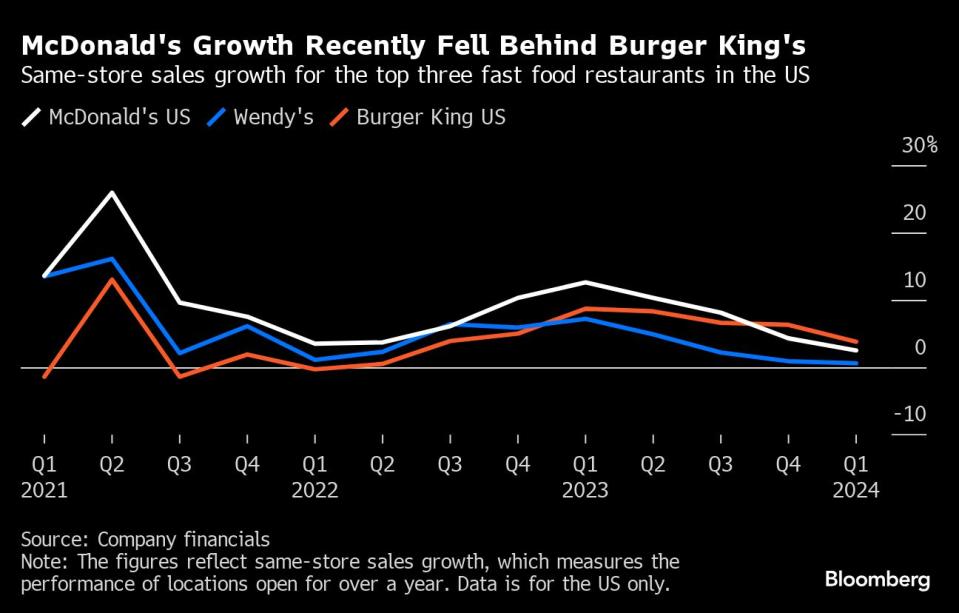(Bloomberg) — McDonald’s (MCD) Corp.’s U.S. chief says the company is ready to fight.
Most read on Bloomberg
And to win, the hamburger chain draws one of the most powerful weapons in its arsenal: the quality meal. It’s all part of an attempt to re-attract frugal customers who have cut back on fast food after flocking to the Golden Arches in recent years.
On June 25, McDonald’s will launch a marketing campaign and a new $5 meal deal, raising the stakes as U.S. restaurants compete to once again attract inflation-weary diners.
“We are determined to win the war for values,” Joe Erlinger, president of McDonald’s U.S., said in an interview with Bloomberg News.
Last month, after Bloomberg News reported on McDonald’s plans for the $5 promotion, competitors came back with their own offers — and insults.
Burger King’s US president has pledged to roll out its $5 meal “before them”, referring to McDonald’s in a memo to franchisees. Wendy’s (WEN) Co. offered a $3 breakfast deal and took to social media to mock competitors for copying its ideas. Even Starbucks (SBUX), known for its pricey Frappuccinos and lattes, announced it would offer a $6 breakfast sandwich and coffee combo.
When asked about his opponents, Erlinger smiled and said he wasn’t obsessed with competing.
As the largest restaurant chain in the United States by revenue, he said McDonald’s size and marketing power give the $130 billion company an advantage over smaller and smaller competitors. the ability to reduce any impact on franchisee profits. “Think about our scale,” he said, noting that the additional cost of adding fries and a drink to a sandwich was minimal. The $5 deal includes a McDouble or McChicken sandwich, small fries, four-piece chicken nuggets and a small soft drink.


Not all franchisees, who operate the majority of McDonald’s stores, agree with this calculation. Many say they’re hungry for a quality meal that draws customers, but worry people will pass up more expensive options, like the $9 Big Mac combo.
“There is simply not enough profit to cut 30% from this model to be sustainable,” a group of independent franchisees said in a message to its roughly 1,000 members last month.
The company said a local $5 promotion in upstate New York performed well with lower-income consumers while generating incremental sales from wealthier customers who purchase more than the simple $5 meal deal.
For McDonald’s though, the promotion — which runs for four weeks nationwide and longer in markets like Dallas and Las Vegas — isn’t just about boosting sales. The national campaign also aims to dispel the notion that McDonald’s has become too expensive after images of an $18 Big Mac combo meal in Connecticut went viral on social media as well as claims that the prices have doubled in recent years.
The company’s prices have increased an average of 40% since 2019 to offset rising costs, Erlinger said in a blog post in May. He said the $18 price was an anomaly found at only one of the company’s 13,700 locations.
That’s little comfort to customers like Dylan Covington, 33, who lives in Fort Wayne, Indiana, and used to eat at McDonald’s about once a week. The price increases prompted him to cut out his visits to McDonald’s every two or three months. Instead, he said he was going to a local restaurant where he could get a larger sandwich for about the same price.
“McDonald’s has always been the cheaper option,” Covington said. “Now it’s not even that. I don’t see any reason to go there unless I specifically want a Big Mac.


Consumer decline
As prices rose across the United States, McDonald’s local offerings simply weren’t enough to attract customers like Covington again. As the economy continues to churn and the unemployment rate remains low, real disposable income growth in the United States has stalled. Americans have exhausted much of their pandemic-related savings and debt is starting to pile up. Dining out has decreased, and for many, even fast food is increasingly reserved for a special treat.
McDonald’s competitors were the first to increase their value offerings, with Arby’s offering a $6 meal deal in January and White Castle offering a $5 bacon package in April. McDonald’s sales initially held up better than those of its competitors, and the company took a wait-and-see approach.
“It seems like they were caught off guard in terms of value,” said Sara Senatore, an analyst at Bank of America.
Erlinger said customers are becoming more “savvy about where they spend their money.” So the company decided to offer a larger national deal to franchisees, who own and operate 95% of the U.S. locations and can weigh in on major marketing campaigns. Operators initially rejected the promotion out of concern for profit, but eventually agreed, encouraged in part by additional funds provided by Coca-Cola Co.
McDonald’s is also offering additional promotions, like free fries, to customers who order through the fast food chain’s app, a key part of the company’s growth strategy. App users order more often and are more likely to add drinks, desserts and other extras that increase check sizes and drive sales.
The $5 meal promotion probably won’t provide an instant solution. The company’s initial dollar menu debuted in 2002, revamping it several times before arriving at a $1-$3 range in 2018. Although the value menu ultimately generated good results, The initiative took time to gain traction, CEO Chris Kempczinski told Avril investors about the 2018 value menu.


Price perception
McDonald’s declined to detail its promotional plans beyond this summer, although Erlinger said it’s fair to say the promotion isn’t the fast food chain’s last word on value. “We’re obviously going to remain competitive on value and affordability beyond the $5 meal deal.” Right now, customers aren’t looking for new products or creative takes on McDonald’s nuggets, burgers or wraps. “They’re asking for value and affordability,” he said.
For their part, competitors say they are ready to do battle with the heavyweights in the restaurant industry. Patrick Doyle, president of Restaurant Brands International Inc., parent company of Burger King, said the increased focus on value could help support the entire industry.
“It feels like prices may have gotten a little too high,” Doyle told investors in mid-June. The value talk “will hopefully help perceptions around the category in general – inspire some people to open their minds to returning.”
Most read from Bloomberg Businessweek
©2024 Bloomberg LP